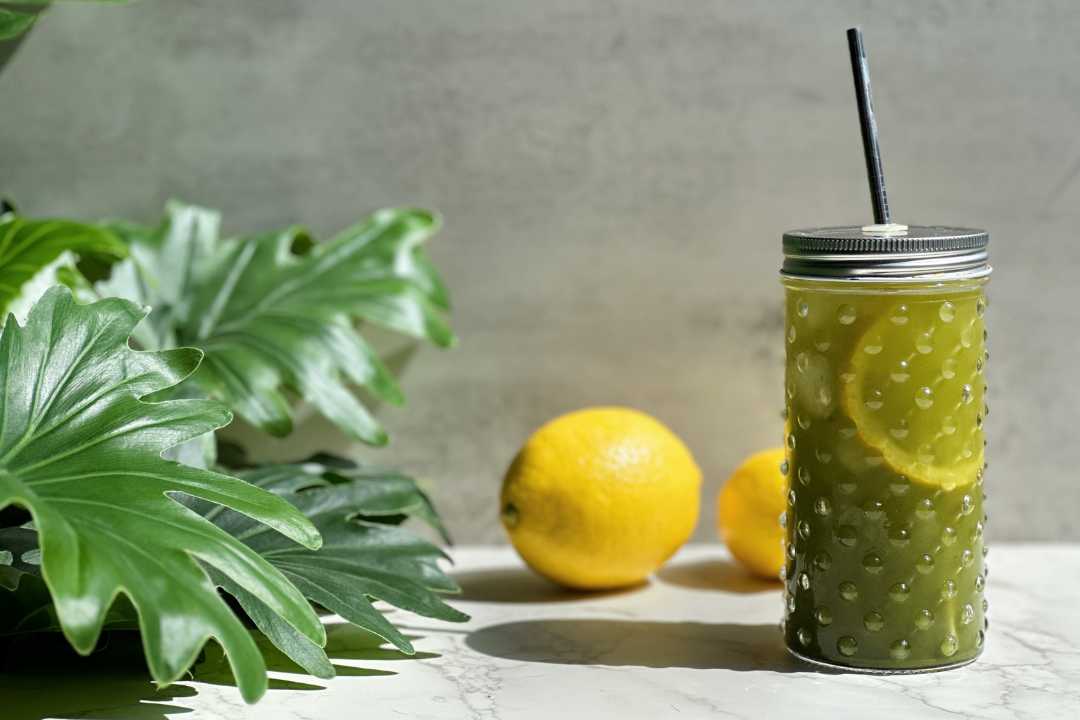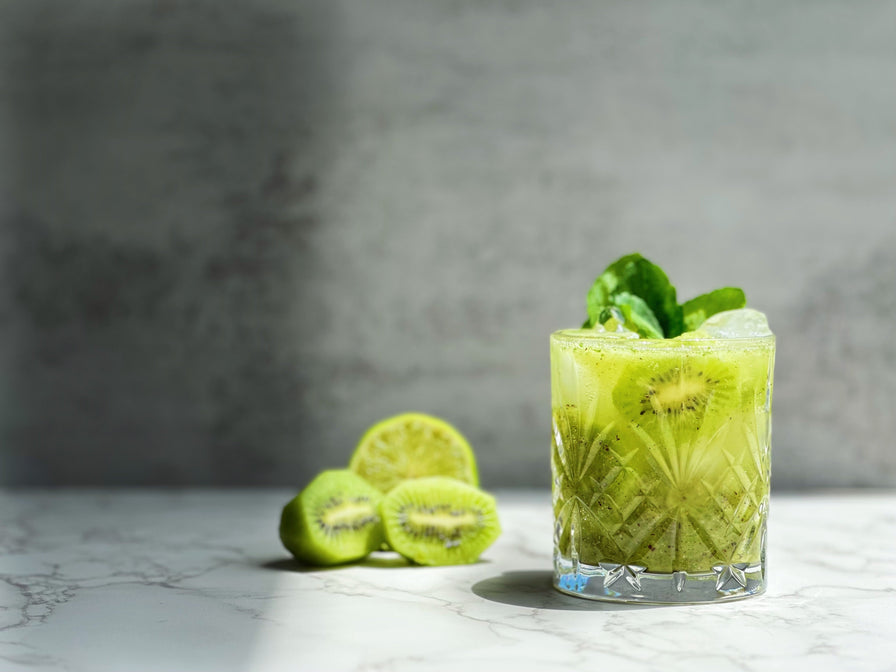
Matcha Spritz

Let's cut to the chase: you're here because you have a soda machine, a love for matcha, and a burning desire to combine the two into one fizz-tastic beverage. Welcome to the land of homemade Matcha Spritz! We're going to transform your kitchen into a mini soda shop. Grab your sparkling water, your finest matcha powder, and let's get started on this bubbly, green, caffeine-packed adventure.
How to Make Matcha Spritz
Matcha Spritz
Ingredients
Instructions
What is Matcha?

Matcha is a type of powdered green tea that originates from Japan. It's made by taking young tea leaves and grinding them into a bright green powder. The powder is then whisked with hot water. This is different from regular green tea, where the leaves are infused in water and then removed.
Join the CO2 Refill Club and Never Run Out of Bubbly Drinks!
Drinking brewed matcha means you’re drinking the actual leaves, and getting a higher concentration of the antioxidants, vitamins, and nutrients. Plus, it has a unique, creamy taste that's often described as grassy and slightly sweet. A fine matcha is a bright, vivid, springtime-in-your-mouth kind of green, while the flavor is rich and deeply satisfying. Now, isn't that a cup of tea worth spritzing up?
What Are the Benefits of Matcha?
Matcha is more than just a trendy, Instagrammable green drink. It's a powerhouse of health benefits! Let's break it down:
-
Antioxidant Haven: Matcha is rich in catechins, a class of plant compounds acting as natural antioxidants. These tiny heroes help to stabilize harmful free radicals that can damage cells and cause chronic disease.
-
Mental Focus Booster: Thanks to the presence of a special compound called L-theanine, matcha can boost brain function. So, if you're in a mid-afternoon slump, a matcha spritz might be just the brain-boosting bubbly you need!
-
Heart Health: Some studies have linked drinking green tea, including matcha, to a reduced risk of heart disease.
-
Weight Loss Friend: Ever noticed how many weight loss supplements list green tea on their ingredients? That's because it's believed to increase fat burning and boost metabolic rate.
So, not only is your matcha spritz delicious and refreshing, it's also doing some pretty great work for your body. Not to mention the health benefits of sparkling water makes this Matcha Spritz a health drink for the books!
How to Refill Your Soda Maker's Empty CO2 Canisters
If you've run out of spark and your soda maker is laying low, fret not! Soda Sense Refill Club has got you covered. With a straightforward swapping system, we ensure you never run out of the bubbles you love. When your CO2 canister is empty, simply place it in the box your refills arrived in, apply the return label, and drop it off at any USPS location. Once they scan your label, we automatically create a new order for you and send you more refills that same day. It's a cycle as smooth as your Matcha Spritz! Remember, you're not just refilling a canister; you're refueling your bubbly adventures. So, why wait? Join the club and keep the fizz flowing!
Optional Sweeteners

While honey is our sweetener of choice, you can certainly mix it up to tickle your taste buds. Here are a few alternatives that you can experiment with:
-
Agave Nectar: A plant-based sweetener that's a favorite among the vegan community. It has a low glycemic index (won't spike your blood sugar levels).
-
Stevia: A zero-calorie sweetener that is derived from the leaf of the Stevia plant. It's much sweeter than sugar, so a little goes a long way!
-
Maple Syrup: This gives your spritz a hint of that autumnal, breakfast pancake flavor. Plus, it comes with its own set of health benefits.
-
Coconut Sugar: A low-glycemic index sweetener that adds a subtle caramel-like flavor to your spritz.
-
Sugar-Free Simple Syrup: For those who want the sweetness without the calories, a sugar-free simple syrup could be your go-to.
Remember, these are just guidelines. Feel free to play around with different sweeteners until you find your perfect match(a)!
Does Matcha Contain Caffeine?
Yes, matcha does contain caffeine. However, it's not the same jolt you get from downing a shot of espresso. While matcha does contain more caffeine than a regular green tea cuppa, the caffeine in matcha is released slowly over several hours as opposed to all at once. This means you get a steady state of alertness (with no crashes!) that could last up to 6 hours. Think of it as the 'tortoise' in the 'caffeine race' - slow, steady, and winning at keeping you awake and focused. So go ahead and enjoy your matcha spritz without worry about the caffeine shakes! It's the perfect pick-me-up for those drowsy afternoons.
Related Read: Healthier Alternatives to Coke
A Deeper Dive Into Matcha Powder: Frequently Asked Questions

Now that you're familiar with the basic benefits of matcha, let's delve a little deeper into this marvelous green powder and answer all those burning questions:
How is Matcha Made?
The production of matcha is a labor-intensive process that begins several weeks before harvest. The tea bushes are covered to prevent direct sunlight, slowing down growth and stimulating an increase in chlorophyll levels, which turns the leaves a darker shade of green and increases the production of amino acids. The finest tea leaves are hand-picked, steamed to prevent fermentation, and then air-dried. The dried leaves are then stone-ground into a fine powder, which is the matcha you know and love.
Can Matcha Keep You Awake?
Yes, matcha can indeed keep you awake. Much like coffee, matcha contains caffeine which is a known stimulant. However, it's important to note that the caffeine release in matcha differs from that in coffee. Matcha provides a sustained energy boost across several hours, rather than the sharp spike and subsequent crash often experienced with coffee. This is due, in part, to the presence of L-theanine, an amino acid that promotes relaxation and helps moderate caffeine's stimulatory effects.
Related Read: Sparkling Water: A Healthy Alternative to Diet Soda
How Long Does Matcha Keep You Awake For
Matcha, like other types of green tea, contains caffeine. The exact amount can vary, but typically, a cup of matcha tea has around 70 milligrams of caffeine. For reference, a cup of coffee has about 95 milligrams of caffeine. The effects of caffeine can last for several hours, typically ranging between 3 to 5 hours.
However, it's also worth noting that the way each individual metabolizes caffeine can vary, so the exact duration of its effects can differ from person to person. Aside from the caffeine, matcha also contains an amino acid called L-theanine, which produces a calming effect and can somewhat counterbalance the stimulating effect of the caffeine. This combination results in a more steady and prolonged energy boost, without the typical caffeine crash.
What Does Matcha Taste Like?
The taste of matcha is quite unique and can vary depending on the quality of the powder. High-quality matcha has a smooth, slightly sweet taste with a hint of bitterness. Lower-grade matcha can be more bitter and astringent. The flavor profile can be described as grassy, vegetal, and sometimes umami.
How Else Can I Use Matcha Powder?
While we've been talking about using matcha in a spritz, it's impressively versatile! The powder can be used in everything from smoothies to lattes, ice creams to cakes. Owing to its high antioxidant content, matcha is also a fantastic ingredient for skincare. When applied topically, these antioxidants help to rejuvenate the skin by fighting against free radicals, reducing inflammation, and slowing down skin aging. Some even swear by matcha face masks for treating acne and improving skin elasticity. You can make a simple matcha face mask by mixing matcha powder with a bit of honey and water, or you can find matcha as a key ingredient in many skincare products. However, as with any skincare product, it's always smart to do a patch test first to make sure you don't have any adverse reactions. Don't be afraid to experiment and find new ways to enjoy this green tea powerhouse.
What is the History of Matcha?
Rooted in Zen Buddhism, the history of matcha stretches back to the Tang Dynasty in China, where tea leaves were steamed and formed into tea bricks for easy storage and trade. The tea was prepared by roasting and pulverizing the leaves, and mixing the resulting tea powder with hot water and salt. During the Song Dynasty, the method of making powdered tea from steam-prepared dried leaves became popular. Zen monk Eisai brought this tea method and the seeds to Japan in the late 12th century, where it evolved into the ceremonial preparation of matcha we recognize today.
The ritual of preparing and consuming matcha became a central part of the Japanese tea ceremony, or Chado, during the 16th century under the influence of Sen no Rikyu, a Japanese tea master. Rikyu's approach to the ceremony – rustic simplicity, directness of approach, and honesty of self – is still followed in Japanese tea ceremonies today.
Over the centuries, matcha fell out of favor in China and became almost exclusively a Japanese drink prepared in traditional tea ceremonies. Its popularity in the Western world came much later, around the 20th century, becoming a favorite in health and wellness circles for its unique flavor and health benefits.
Start Your Bubbly Matcha Journey Today!
So, there you have it—matcha in a nutshell, or should we say, in a tea leaf! Enjoy your matcha spritz, knowing that you're sipping on a beverage with a rich history, profound spiritual significance, and incredible health benefits. Dont forget to follow us on Tik-Tok, Instagram, or Facebook to see this drink come to life! Make sure you tag us if you make our drinks, so we can show you off!
Get 20% off your First CO2 Canister Refill!* Click the button below to have your promo come automatically applied at checkout.
*PROMOTION IS ONLY AVAILABLE FOR FIRST TIME REFILL CUSTOMERS ONLY
Recommended reading



